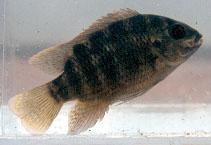| Family: |
Cichlidae (Cichlids), subfamily: Pseudocrenilabrinae |
| Max. size: |
37 cm TL (male/unsexed) |
| Environment: |
demersal; freshwater, |
| Distribution: |
Africa: coastal zone around the Ogooué, Kouilou-Niari and Chiloango (Ref. 81651) up to the mouth of the Congo River (Ref. 55074, 74387). Reported from around the Cuanza delta in Angola (Ref. 5163), but Cuanza specimens identified as Tilapia cf. cabrae in Ref. 120641; may need verification. Also reported from the Bengo River in Angola (Ref. 120641) and from southern Equatorial Guinea (Ref. 5163, 52307). |
| Diagnosis: |
Dorsal spines (total): 16-17; Dorsal soft rays (total): 11-14; Anal spines: 3-3; Anal soft rays: 9-11. Diagnosis: 12 or more rakers on lower limb of first gill arch; outer row jaw teeth gracile and somewhat spatulate; adults with dark, broad vertical stripes on flanks; ventral scales with small irregular red-brown spots; head profile straight; lower pharyngeal jaw with relatively strong teeth not forming a felt-like covering (Ref. 81260).
Description: deep-bodied, with a relatively short head (Ref. 52307), its length 32.4-37.0% SL (Ref. 81260). Remarkably rounded frontal profile in adults; caudal fin rounded (Ref. 52307). Lower pharyngeal jaw with pointed, curved anterior teeth and larger posterior teeth, generally with 2 secondary cusps; ventral keel shorter than dentigerous plate; 4-7 tooth rows in oral jaws, teeth on outer rows bicuspid and spatulate (Ref. 81260).
Coloration: adults: yellowish; lower lip, throat, chest and belly whitish; upper lip, snout and dorsum of head dark olive-green; 6-8 vertical stripes on body and caudal peduncle, with narrow interspaces; base of each flank scale marked with a fine black, sickle-shaped spot; between upper lateral line and belly, many small wine red spots are irregularly distributed (as many as 1-3 per scale); unpaired fins greenish, with few clear maculae between soft rays; pelvics greenish or greyish, with a whitish leading edge (Ref. 81260). Juveniles generally yellow, with 7-8 dark, vertical stripes; fins greyish or transparent; dorsal fin with yellow distal margin; yellow maculae between caudal rays and soft dorsal and anal fin (Ref. 81260). |
| Biology: |
Maximum standard length reported is 37.0 cm (Ref. 81260). Probably pair bonding (Ref. 52307). Open (Ref. 52307) substrate brooder/spawner (Ref. 52307, 81260) with both parents guarding the brood (Ref. 52307). |
| IUCN Red List Status: |
Least Concern (LC); Date assessed: 01 May 2009 Ref. (130435)
|
| Threat to humans: |
harmless |
Source and more info: www.fishbase.org. For personal, classroom, and other internal use only. Not for publication.

